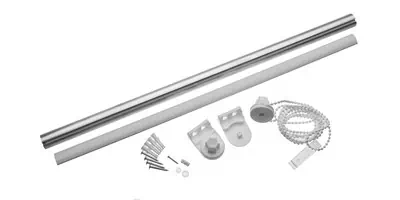There are lots of different types of fabric blind, so which style is right for you? The type of blind you choose is important as it can change the whole look of your room. Read on to find out all about the different types of fabric blinds!
Do you want to know how to choose a fabric blind? Read on to find out more!
Fabric blinds can match or contrast with other window dressings, and different styles of window blind can make your windows look relaxed or more formal.
Why are fabric blinds a good choice?
You can use fabric blinds to add a pop of colour at your window, or to contrast or match with existing curtains. Fabric blinds can be used to make a real statement at a window. If you opt for fabric blinds, the fabric is flat, not gathered, so roman blinds and other fabric blinds will really show off a dramatic fabric.
Fabric blinds can have a blackout lining to cut down on light pollution and reduce glare. Blackout or thermal linings both have good thermal properties, helping to keep your room cooler in summer or warmer in winter.
Roman blinds can also have a layer of interlining – we recommend lightweight poly interlining – which adds a feeling of opulence to the fabric and also helps insulate the windows.
What is the best type of fabric blind to buy?
There are lots of different types of blinds! You’ve probably heard of roman blinds and roller blinds, but what about a Swedish or Austrian blind? What do they look like, and how are they all different?
All these types of fabric blinds will soften the appearance of your room, frame your windows, keep your room warmer, and absorb sound to make your space feel more cosy, but they’re all quite different. Some finishes are more modern and others more traditional. Ready to find out more?
Before we start, here’s a glossary of some terms you’ll see in this article:
- Header: The top part of the blind that is visible when the blind is fully folded or rolled.
- Show fabric: The decorative fabric that you choose for your blind
- Interlining: An extra layer that goes between the show fabric and the lining, adding warmth and fullness.
- Child safety device: A quick-release device that will come apart under pressure.
- Window recess: The opening within a wall where the window frame sits.
- Cleat: Metal fixing screwed to the wall or frame at the side of the blind. The blind cords are wound round the cleat when the blind is raised to hold it in place.
So what are the different fabric blinds?

1
Roman blinds
What is a roman blind? Roman blinds are probably the most popular fabric blind. The fabric is a flat panel when the blind is down, which shows off your choice of show fabric beautifully.
A roman blind is constructed with pockets which contain rods. The blind pulls up into soft folds at the top of the window, with a rod at the bottom of each fold.
Order made to measure roman blinds from us, or make your own using our useful roman blind component kit.
Roman blind styles
The traditional method has a wooden batten and strings to pull up the blind which are attached together with an acorn. A cleat on the wall is needed to secure the blind when it’s open.
The cassette system is a complete unit which the blind is attached. The strings are all contained neatly within the cassette , and the blind is operated with a continuous beaded chain on one side. With a cassette roman blind, no cleat is needed to secure the blind.
Things to consider when choosing a roman blind
Child safety is very important with roman blinds due to the risk of getting caught in the strings. All roman blinds now legally have to be fitted with child safety devices and these come as standard with our made to measure roman blinds. They are also included in our roman blind accessory packs. Chain operated roller blinds also need a chain safety device.
Header size: Roman blinds always cover the top of the window whether they’re hung within the window recess or above the window. For blinds within the window recess it may be worth requesting a narrower than standard header, especially if the windows are small, to reduce the loss of light from the window.
Blackout lining can be used to make the blind, though there will be the potential for light to show along the lines of stitching. For blackout blinds we would recommend fixing outside the window recess if possible.
False blinds: Roman Blinds can also be made up as false blinds which dress the top of the window but don’t lower to cover the window. This can be very effective for cafes etc where you need to reduce echoes and dress the windows, but don’t want to close the blinds.
Positioning: A roman blind can be hung at the window in two ways, either within the recess just covering the window, or across the recess, covering the entire opening.
Do you want to make a roman blind at home? Find out more about how to calculate how much fabric you need for a roman blind here.
.

2
Swedish blinds
What is a Swedish blind? Swedish blinds are a simple-looking style of blind that rolls up from the bottom, using cords. These blinds give a rustic, relaxed finish to your window, and are flat when rolled down, which shows off your choice of show fabric.
Choose a Swedish blind if you want a soft, simple, unstructured window covering as these blinds don’t have rods to hold the fabric in place like roman blinds.
Because they’re rolled up, you can choose a decorative fabric for the reverse.
Things to consider when choosing a Swedish Blind
Fabric: For a Swedish blind you can choose two show fabrics, as the back of the blind which will be seen when the blind is closed. The reverse of the blind is seen in the roll as the blind is opened, and is visible through the window when the blind is closed.
Blackout: If you need a blackout blind, blackout lining can be used as an interlining. Some light will usually get around the edges of the blind, but you will not have the lines of stitching as with blackout roman blinds so swedish blinds may be a good option for blackout..
Traditional interlining is another option. A lightweight cotton or polyester interlining will increase heat retention when the blind is closed. We would not recommend a heavy interlining as this makes the blind too bulky to roll up.
Attaching the blind: This type of blind is most suitable for smaller windows, and is fixed to a wooden batten using velcro. A cleat will be needed on the wall for tying off the cords to keep the bliind open. For child safety the blind should be at least 1.5 metres off the floor when fully closed.

3
Roller blinds
Roller blinds have a completely flat finish and roll away into a header when opened. The header can either be spring loaded or more commonly will use a chain system to roll the blind away.
Plain blinds can be purchased complete, or you can use our roller blind kits and a fabric of your choosing to create your own blind to fit in with your decor. Just use the ‘roller blind’ filter to find a suitable fabric.
You can also use our roller blind backing to re-use an existing roller blind with fresh fabric.
Things to consider when choosing a roller blind
Fabric: If you’re making it yourself, bear in mind that not all fabrics are suitable for making into roller blinds. Generally you want a fabric which is not too heavy or textured. The best are simple curtain weight cottons. You can find a suitable range of roller blind fabrics in our shop here.
Blackout: Roller blind backing will slightly reduce light coming in the window, but does not have full blackout properties. If you don’t already have your roller blind fixings you can buy a roller blind kit which includes the roller blind backing. This kit makes a blind up to 120cm wide and 120cm long, but several sizes are available.

4
Austrian blinds
What is an Austrian blind? Austrian blinds are a very traditional-looking blind. When the blind is down the fabric is ruched up on strings to create soft swags.
There are no rods in the blind, so the fabric in the middle of the blind will drape softly at the window.
Austrian blinds are usually made with light fabrics like cotton voile. They may have a ruched or lace finish to the bottom edge.
Choosing from the different types of fabric blind is an important step in designing the soft furnishings in your room. We hope this guide will help you make the right decision to get exactly the look you want.



0 Comments